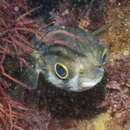en
names in breadcrumbs


The slender-spined porcupine fish[1] or globefish[2] (Diodon nicthemerus) is a porcupinefish of the family Diodontidae, found in the waters of southern Australia, as far north as Port Jackson to Geraldton, Western Australia. It is most common in Port Phillip Bay and the coastal waters of Tasmania in shallow coastal waters and under manmade jetties. It is known to occur at a depth range of 1 to 70 m (3 to 230 ft).[3]
Diodon nicthemerus is similar in appearance and size to the three-bar porcupinefish (Dicotylichthys punctulatus), with both species reaching around 40 cm (15.7 inches) in total length, although patterning and morphology can differentiate the two. It is nocturnal, occasionally forms small groups, and feeds on benthic zone invertebrates. It possesses slender yellow spines used for defence against predators and has the ability to inflate its body so its sharp spines protrude when alarmed.[3]
{{cite web}}: CS1 maint: url-status (link)  An individual of D. nicthemerus photographed at night.
An individual of D. nicthemerus photographed at night. The slender-spined porcupine fish or globefish (Diodon nicthemerus) is a porcupinefish of the family Diodontidae, found in the waters of southern Australia, as far north as Port Jackson to Geraldton, Western Australia. It is most common in Port Phillip Bay and the coastal waters of Tasmania in shallow coastal waters and under manmade jetties. It is known to occur at a depth range of 1 to 70 m (3 to 230 ft).
Diodon nicthemerus is similar in appearance and size to the three-bar porcupinefish (Dicotylichthys punctulatus), with both species reaching around 40 cm (15.7 inches) in total length, although patterning and morphology can differentiate the two. It is nocturnal, occasionally forms small groups, and feeds on benthic zone invertebrates. It possesses slender yellow spines used for defence against predators and has the ability to inflate its body so its sharp spines protrude when alarmed.